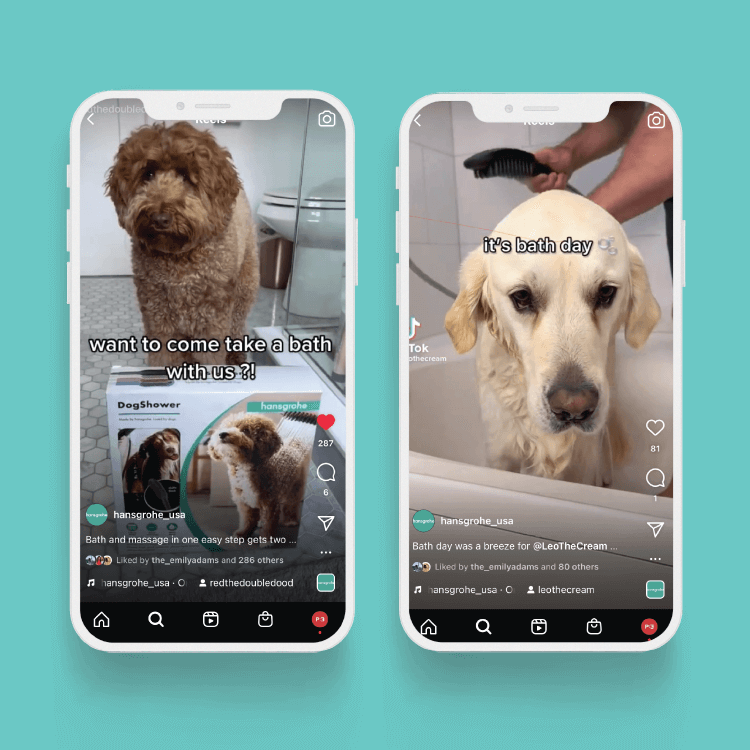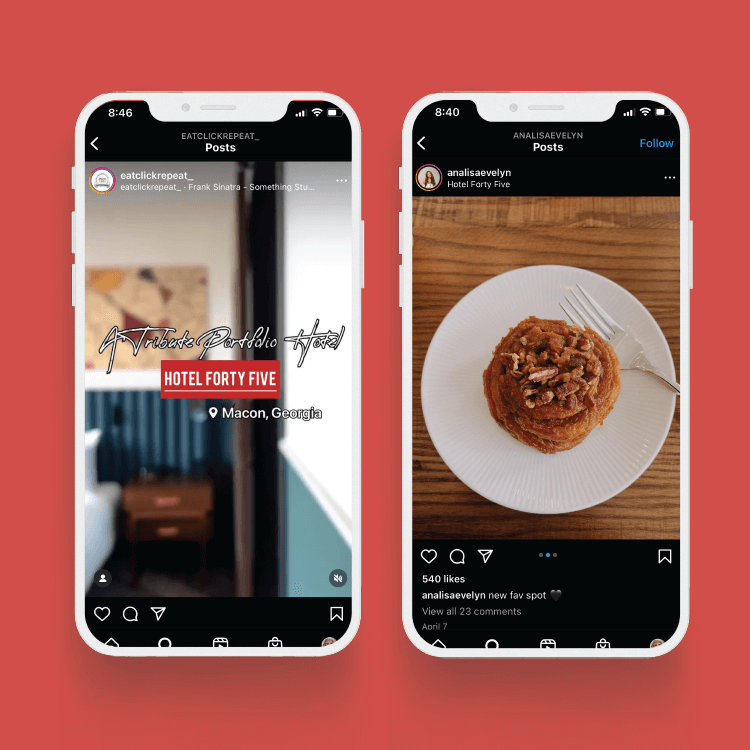Recently, Phase 3 asked five dog influencers (or dogs with their own social media accounts, to be more precise) to promote the new DogShower product for Hansgrohe, a luxury kitchen and bath faucets and showers manufacturer. The DogShower was Hansgrohe's first product sold directly to consumers and a market segment they had never tapped before. Our influencer campaign was part of a more extensive integrated marketing campaign designed to introduce this new product line and to increase consumer brand awareness of Hansgrohe in the U.S. and Canada.
Why did we use dog influencers? Because these dogs (yes, the dogs!) each have 1 million followers on Instagram and TikTok. They engage with their fans daily and can easily sway public opinion about the products they endorse. In other words, they INFLUENCE consumers with dogs, the target audience for Hansgrohe’s new DogShower.
The campaign was a success. One dog’s Instagram posts netted more than 300K plays and 10K likes. Another's TikTok posts gathered more than 25k plays and 2,500 likes.

As a public relations strategy, influencer marketing is incredibly effective these days. But, believe it or not, influencers predate social media.
The History of Influencer Marketing
Consumers have long depended on third-party brand endorsements to inform them of what they should buy and where to go. We can trace the act of influencer endorsements back to Ancient Rome when gladiators endorsed products.
Before the internet became a thing, advertising found in traditional media outlets like newspapers and magazines were influencers. In the early days of advertising, brands used celebrity spokespeople to "influence ."For example, Bing Crosby, Humphrey Bogart, John Wayne, Bob Hope, and Elizabeth Taylor are among the many movie stars who appeared in "The Saturday Evening Post" magazine ads endorsing Whitman's Chocolates. The company says that “compensation for these endorsements is in boxes of chocolates and a mention of the star's upcoming motion picture.”
While Whitman mentioned the influencer’s movie in their ads, product placements in movies also became a powerful form of influencer marketing. For example, consumers were “influenced” by James Bond to drive Aston Martins and by Forrest Gump to wear Nike sneakers. Sometimes, the spokesperson wasn’t even a real person – for example, the Marlboro Man – but a character that an “Average Joe” might aspire to be like.
Influencer Marketing Today
Today, the average consumer no longer trusts traditional advertisements or fictional spokespeople. Instead, they ask their friends and family who have experience with a product for recommendations. They look for, and trust, product reviews given by ‘real’ people. Consequently, influencer marketing has shifted along with the attitudes of the consumer. These days, influencer marketing involves consumers seeking product reviews from social media content creators whose values they align with and whom they aspire to be like. Many of these influencers are regular people (or their dogs), not celebrities. They build their profiles on a lifestyle or a passion (like being a dog parent), not a widely viewed movie or television show. Today’s influencer marketing is based on trust and aspiration.
The Dollars Involved in Influencer Marketing
Influencer marketing has become a big business, with $16.4 billion spent in 2022. And it is lucrative; companies make $5.20 on every $1 spent on influencer marketing. As a result, influencer marketing spending will grow 23.4% and 15.9% year-over-year in 2023 and 2024. Companies funnel more of their ad budgets to influencer marketing than traditional ad channels.
Influencer marketing used to be the platform for consumer products exclusively, but not any longer. Industries you wouldn't expect to benefit from an influencer campaign are jumping on board, like niche or tech B2C companies and B2Bs. The returns have shown that influencer marketing can be a game-changer when used within a larger integrated marketing campaign.
But what is an effective influencer marketing strategy? Collaboration is at the heart of today's influencer marketing. The most successful collaborations are between brands and influencers that have a natural connection and with influencers who are genuinely influential.
Who Are Influencers?
It depends on the audience and the market. Generally, an influencer can find, speak credibly to, and engage a target audience in a conversation about a product or service. In the past, influencers have been celebrities, journalists, artists, or other well-known people. Today, they can be bloggers, TikTok creators, or thought leaders in your market. With the right marketing and PR strategy behind them, your CEO can be an influencer. They could be your most loyal customer. Or, as we’ve seen in our Hansgrohe example, it can even be a dog.
Where Do You Find Good Influencers?
Most influencers have built a reputation for their knowledge and expertise on a specific topic, often on social media. They make posts regularly on their topic and engage with enthusiastic fans who pay close attention to their comings and goings. If they are experts in a topic that is important to your brand, their fans are (or could be) your customers. For example, if you own a restaurant chain, a chef with a popular YouTube channel would be a great influencer for your brand because their fans are foodies. But remember, an influencer should be someone who is an organic reflection of your brand. If your restaurant chain specializes in organic whole foods and the chef is popular for frozen food hacks, they are probably not the best fit for your brand,
What Makes Influencers Effective
The size of their fanbase does have to be huge for an influencer to be credible. However, in many cases, micro-influencers are a viable option. Micro-influencers share their passions with an online audience of 1,000 to 5,000 followers. These influencers can move the needle on brand awareness and sales. Why? Because their followers tend to be highly engaged.
That engagement is critical. Having a lot of followers is great, but engagement is the sweet spot in influencer marketing. Engagement is when two-way conversations happen between an influencer and a follower, which often leads to actions like making a purchase. Think of social following as lurking, while engagement is interaction. In this way, micro-influencers can be more effective than influencers with hundreds of thousands of followers because they can authentically interact with their fans one-to-one.
Your most loyal customers are also impactful influencers. A 2021 study reported that 98% of consumers feel that reviews are an essential resource when making purchase decisions, up from 89% in 2018. The same survey showed that reviews and online ratings have become more important to the purchase decision, even above price. So what better way to leverage influence than to give your best fans an incentive to talk you up online even more than they already do?
Our client, Hotel Forty-Five, regularly invites influential guests from different markets throughout the southeast for a staycation. During this staycation, the guests are offered dinner at the signature restaurant, Loom; drink tickets at the rooftop bar, Hightales; and breakfast from Reckon, the coffee bar. Additionally, the hotel asked the guests to document their staycation on their social media channels. As a result, not only does the hotel benefit from the initial social push, they earn loyal customers who will authentically recommend them to their highly engaged audience whenever they can.

That long-term view is essential when planning an influencer marketing strategy. Influencer marketing is an investment in brand building, not just an advertising or marketing campaign.
What Influencer Marketing is Not
Influencer marketing will not create quick results. It's the same slow-and-steady approach as content marketing, where you intend to build your brand, not trigger instant sales (although that would be good, too!)., It’s purpose is to demonstrate your brand's credibility, authenticity, and thought leadership within your industry.
Influencer marketing is not a stand-alone marketing tactic. At heart, influencer marketing is a public relations strategy. As with any PR strategy, it is the most effective when paired with other marketing channels to create a comprehensive campaign. For example, the integrated campaign could include more social media content, emails, SMS texting, brick-and-mortar sales events and signage, and direct mail.
Influencer marketing is not a one-size-fits-all strategy. There are many tactics, channels, and approaches to influencer marketing. Expand your approach beyond the norm. Tailor your plan to your brand, goals, audience, and influencers.
Measuring the Results of Influencer Marketing
As with everything else, how you measure the success or failure of an influencer marketing strategy will depend on your goals. The most straightforward measurements are digital impressions, reach, and engagement on social media. You could also measure how many people took your influencer's call to action. You could measure traffic to your website, brick-and-mortar locations, and online or offline sales. All are appropriate measurements of how successful your strategy was. It is possible to assign unique web links to track sales per influencer for online product sales. These links hone the ROI measurement down into something verifiable and actionable.
The Phase 3 Influencer Marketing Process
Our team of experts uses a unique process to build our clients' most effective influencer marketing strategies. What makes it unique is that we start by identifying our client's goals and objectives for the collaboration instead of beginning with an influencer in mind, as many brands do. This focus is important because not every influencer is a good fit for your brand. If your collaboration does not look and feel authentic, your customers and their followers will feel it, and your campaign will not be successful. Our goal is to hand-select influencers who will create a collaboration that feels as organic and natural as possible.
Our team will also develop a complete campaign brief outlining the campaign's tactics, channels, tracking mechanisms, and KPIs. In addition, this brief will list the expectations for both the influencer and the brand. That way, there is a clear understanding of roles, compensation, and how success will be measured. Of course, any influencer campaign can be just one part of an integrated marketing campaign that our team develops to support your brand’s overall business goals.
Regarding compensation, influencers can be paid with cash, product, a portion of product sales, in-kind services, or a combination. Today, 99% of influencers expect a cash payment, and the current going rates for popular influencers will blow your mind. You can spend thousands of dollars on one Instagram video. A brand needs to be creative in creating a compensation package that makes sense for both parties. That's where a partner like Phase 3 can be valuable to your bottom line. The team at Phase 3 will negotiate influencer contracts that work for our clients' budgets.
In this age of online reviews and dogs on Instagram, we can't ignore the power of influencer marketing. If you have yet to engage influencers in your marketing, you must start now. Our PR and marketing experts at Phase 3 can help you build an effective influencer marketing strategy that elevates your brand and enables you to achieve your business goals. Contact us today, and let's get started.